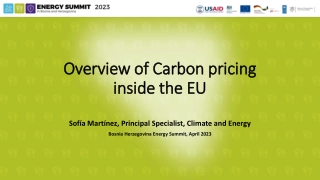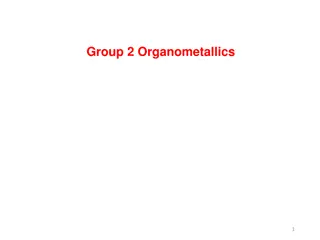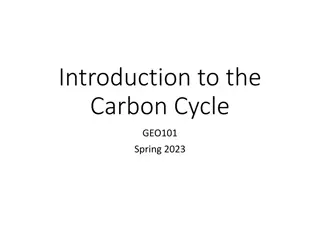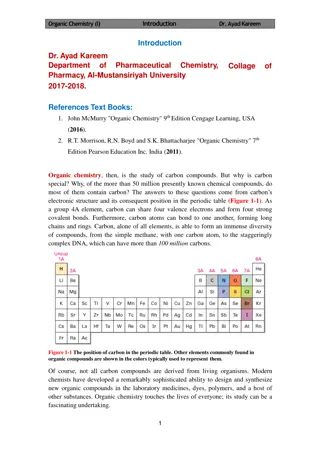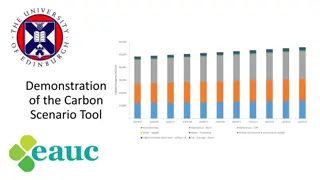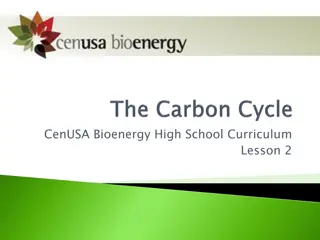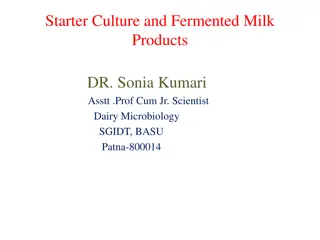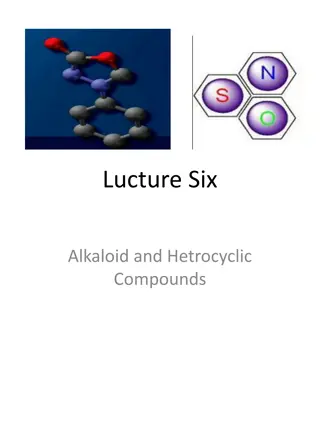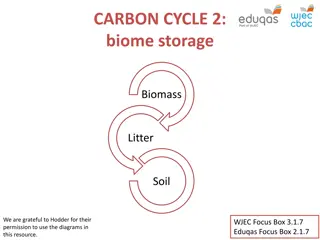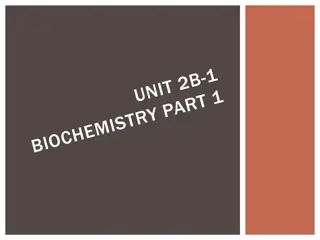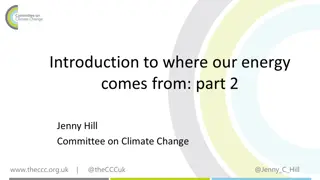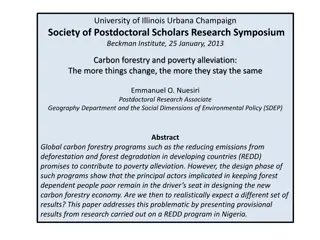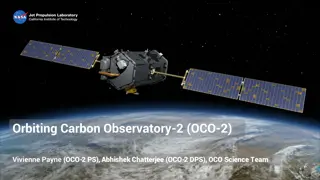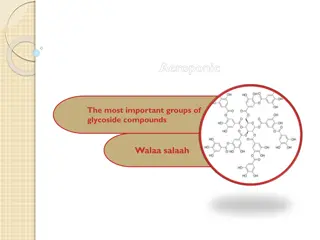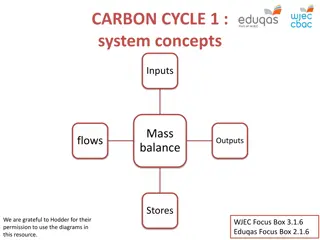
Carbon in Various Forms: Properties and Bonding Techniques
Discover the diverse presence of carbon in nature, from fuels to compounds, and learn about its atomic structure, valency, and bonding properties. Explore covalent bonds through examples like hydrogen and oxygen molecules, as well as compounds like methane and ethane.
Download Presentation

Please find below an Image/Link to download the presentation.
The content on the website is provided AS IS for your information and personal use only. It may not be sold, licensed, or shared on other websites without obtaining consent from the author. If you encounter any issues during the download, it is possible that the publisher has removed the file from their server.
You are allowed to download the files provided on this website for personal or commercial use, subject to the condition that they are used lawfully. All files are the property of their respective owners.
The content on the website is provided AS IS for your information and personal use only. It may not be sold, licensed, or shared on other websites without obtaining consent from the author.
E N D
Presentation Transcript
Carbon is found in the atmosphere, inside the earthscrust and in all living organisms. Carbon is present in fuels likewood, coal, charcoal, coke, petroleum, natural Carbon is present in compounds like carbonates, hydrogen gas, biogas, marsh gas etc. Carbon is found in the free state as diamond, graphite, fullerenes etc.
The atomic number of carbon is 6, its electronic arrangement is 2,4, it has 4 valence electrons. It can attain stability by gaining 4 electrons, losing 4 electrons or sharing 4 electrons with other atoms. It does not gain 4 electrons because it is difficult for the 6 protons to hold 10 electrons. It does not lose 4 electrons because it needs a large amount of energy to lose 4 electrons. So it shares 4 electrons with other atoms to attain stability resulting in the formation of covalent bonds. Since carbon atom needs 4 electrons to attain stability, its valency is 4 and it is tetravalent. X C I _C_ I X X X
Covalent bond is chemical bond formed by the sharing of electrons between atoms. The sharing of one pair of electrons results in the formation of single covalent bond, sharing of two pairs of electrons results in the formation of double covalent bond and sharing of three pairs of electrons results in the formation of triple covalent bond. Eg :- Formation of single covalent bond in Hydrogen molecule - H2 The atomic number of hydrogen is 1, its electronic arrangement is 1, it has 1 valence electron. It needs 1 electron more to attain stability. So two hydrogen atoms share 1 pair of electrons resulting in the formation of a single covalent bond in hydrogen molecule H2. H H H2 * * H * *H H H
The atomic number of oxygen is 8, its EC is 2,6, it has 6 VE, it needs 2 electrons more to attain stability. So two oxygen atoms share two pairs of electrons resulting in the formation of a double covalent bond in oxygen molecule O2 X X O X X XX XX O X X O X X X X O X X X X X X O2 O=O X X X X The atomic number of nitrogen is 7, its EC is 2,5, it has 5 VE, it needs 3 electrons more to attain stability. So two nitrogen atoms share three pairs of electrons resulting in the formation of a triple covalent bond in nitrogen molecule N2 X X N X X N X X X X X X X X X XX X X X N N N2 N X N X
Methane molecule CH4 Ethane molecule C2H6 H H H X X C X X C X X X H H H X X X X H X H H H H I H I H I H C H C C H I H H I I H H
Carbon forms a very large number of compounds. The number of carbon compounds is more than three million. It is more than the number of compounds formed by all other elements. This is because:- 1) Carbon atom can form bonds with other carbon atoms to form long chains, branched chains and closed rings. This property is calledcatenation. 2) Since the valency of carbon is 4, it can form bonds with other carbon atoms or with atoms of other elements like hydrogen oxygen, nitrogen, halogens etc_.C_ I _ I I I C _ _ _ C C C C C C C C I I _ C_ I I I I I I C C C C C C I I I I I I I I C I Long chain Branched chain Closed ring
i) Hydrocarbons :- are compounds containing carbon and hydrogen atoms. ii) Saturatedhydrocarbons :- are hydrocarbons having all single covalent bonds between the carbon atoms. Eg : Alkanes :- have all single covalent bonds between the carbon atoms and their names end with ane. H I H. H I. I Methane CH4 H C H I H Ethane C2H6 H C C H I H I H
iii) Unsaturated hydrocarbons :- are hydrocarbons having a double or triple covalent bond between two carbon atoms. Eg : Alkenes and Alkynes. Alkenes :- have a double covalent bond between two carbon atoms. and their names end with ene. H H I C = C I H H e covalent bond between two carbon atoms and H I H I I H Propene C3H6 H C C C I H Ethene -C2H4 I H Alkynes :- have a tripl their names end with yne. H C C H Ethyne C2H2 Propyne - C3H4
Carbon compounds having the same molecular formula but different structural formulae are called isomers. This property is called isomerism. Eg:- Butane C4H10 has 2 isomers. They are Normal butane and Iso butane. H H H H I I I I H C C C C H I I I I H H H H H I H H I I H C C C H I H H C H Isobutane I H I H Normal butane Pentane C5H12 has 3 isomers. They are Normal pentane, Iso pentane and Neo pentane. Neo pentane H I H C H H I H C C C H I H H C H I H Iso pentane H I H C H H Normal pentane I H I H H H I H I H I H I H I I I I H C C C C C H I I I H H H H C C C C H I I H H H I I I I H H H H
An atom or a group of atoms which decides the properties ofa carbon compound is called a functional group. i) Halide ( Halo group) :- - Cl, - Br, etc. ( Names end with ane) Eg :- CH3Cl Chloro methane, C2H5Br Bromo ethane ii) Alcohol :- - OH ( Names end with ol) Eg :- CH3OH Methanol, C2H5OH Ethanol H ( Names end with al) iii)Aldehyde :- - CHO - C O Eg :- HCHO Methanal, CH3CHO Ethanal iv) Carboxylic acid :- - COOH Eg :- HCOOH Methanoic acid, CH3COOH Ethanoic acid - C - OH (Names end with oic acid ) v) Ketone :- - CO - C - II O (Names end with one) Eg :- CH3COCH3 Propanone, CH3COC2H5 -Butanone
Homologues series Homologus series is a group of carbon compounds having similar structures, similar chemical properties and whose successivemembers differ by a CH2 group. Eg :- Alkanes, Alkenes,Alkynes etc. Alkanes :- have general molecular formula CnH2n+2 . Their namesend with ane and the members are as follows:- - CH4 - C2H6 - C3H8 - C4H10 - C5H12 Methane Ethane Propane Butane Pentane H I Methane : CH4 H C H I H H. I. H I H. I. H H I I Ethane : C2H6 H C C H I H Propane C3H8 H C C C H I H I H I H H I
Alkenes have general molecular formula CnH2n . Their names end with ene and the members are as follows:- Ethene Propene - C3H6 Butene Pentene - C5H10 - C2H4 - C4H8 H. I. C = C I H H I Ethene :- C2H4 I H H. I. H I H I H. I. H H I H I I Propene :- C3H6 H C = C C H Butene :- C4H8 H C = C C C H I H I I H H
Alkynes have general molecular formula CnH 2n 2 .Their names end with yne and the members are as follows:- Ethyne :- C2H2 H C C H H I C C H I H H H I I C C C H I H H Propyne :- C3H4 H C Butyne :- C4H6 H C I
a) Combustion :- Carbon compounds burn in oxygen to form water, carbon dioxide, heat and light. Eg :- C + O2 CH4 + 2O2 C2H5OH + 3O2 3H2O + 2CO2heat + light CO2+ heat + light 2H2O + CO2+ heat + light b) Oxidation :- Carbon compounds like alcohols are oxidised to carboxylic acids on heating with oxidising agents like alkaline Potassiumpermanganate KMnO4 or acidic potassium dichromate - K2Cr2O7. Eg:- Alcohols are oxidised to Carboxylic acids alkaline KMnO4 +heat C2H5OH Ethanol acidic K2Cr2O7 + heat CH3COOH Ethanoic acid
c) Addition reaction:- Unsaturated hydrocarbons undergo addition reaction with hydrogen in the presence of nickel or palladium as catalyst to form saturated hydrocarbons. Eg:- Ethene undergoes addition reaction with hydrogen to form ethane in the presence of nickel or palladium as catalyst. Ni or Pd catalyst C2H4+ H2 C2H6 H. H I. I Ni or Pd catalyst C = C + H2 I I H H The addition of hydrogen to unsaturated hydrocarbons to form saturated hydrocarbons is called hydrogenation. Hydrogenation is used to convert unsaturated oils and fats to saturated oils and fats. d) Substitution reaction :- Saturated hydrocarbons undergo substitution reaction with halogens to form substitution products. Eg :- Methane undergoes substitution reaction with chlorine in the presence of sunlight to form substitution products. CH4 + Cl2 CH2Cl2 +Cl2 CHCI3 +HCl CHCI3 +Cl2 H H I I H C C H I H I H CH3Cl + HCl CH3Cl + Cl2 CH2Cl2 + HCl CCl4 +HCl
11) Some important carbon compounds :- a) ETHANOL :- C2H5OH - Ethyl alcohol Properties :- i) Ethanol is a colourless liquid with a pleasant smell andburning taste. ii) It is soluble in water. iii) Ethanol reacts with sodium to form sodium ethoxide andhydrogen. 2C2H5OH + 2Na 2C2H5ONa + H2 iv) Ethanol reacts with hot conc. H2SO4 to form ethene and water.Conc. H2SO4 is a dehydrating agent and removes water fromethanol. conc. H2SO4 C2H5OH C2H4 +H2O Uses :- i) Ethanol is used for making alcoholicdrinks. ii) It is used as a solvent. iii) It is used for making medicines like tincture iodine, coughsyrups, tonics etc.
b) ETHANOIC ACID:- CH3COOH Acetic acid Properties :- i) Ethanoic acid is a colourless liquid with a pungent smell and sour taste. ii) It is soluble in water. iii) A solution of 5% to 8% ethanoic acid in water is called Vinegar. iv) Esterification :- Ethanoic acid reacts with ethanol to form the ester ethyl ethanoate in the presence of conc. H2SO4. conc.H2SO4 CH3COOH + C2H5OH CH3COOC2H5 + H2O The reaction between carboxylic acid and alcohol to form an ester is called esterification. v) Saponification :- When an ester reacts with sodium hydroxide solution, the sodium salt of the carboxylic acid and the parent alcohol are formed. This reaction is called saponification. Eg :-Ethyl ethanoate reacts with sodium hydroxide to form sodium acetate and ethanol. CH3COOC2H5 + NaOH CH3COONa + C2H5OH vi) Ethanoic acid reacts with bases to form salt and water. CH3COOH + NaOH CH3COONa + vii) Ethanoic acid reacts with carbonates and hydrogen carbonates to form salt, water and carbon dioxide. 2CH3COOH + Na2CO3 CH3COOH + NaHCO3 CH3COONa + H2O + CO2 H2O 2CH3COONa + H2O + CO2
Soaps :- Soaps are long chain sodium or potassium salts ofcarboxylic acids. Eg:- Sodium stearate C17H35COONa Structure of soap molecule :- A soap molecule has two parts. A long hydrocarbon part which is hydrophobic (water repelling) and soluble in oil and grease and a short ionic part which is hydrophyllic (water attracting) and insoluble in oil and grease. Na+ COO Hydrocarbon part (Water repelling) Ionicpart (Water attracting) Cleansing action of soap :- When soap is dissolved in water it forms spherical structures called micelles. In each micelle the soap molecules are arranged radially such that the HC part is towards the centre and the ionic part is towards the outside. The HC part dissolves the dirt, oil and grease and forms an emulsion at the centre of the micelles which can be washed away by water.
b) Detergents :- Detergents are long chain sodium salts of sulphonic acids. Soaps do not wash well with hard water because it formsinsoluble precipitates of calcium and magnesium salts in hard water. Detergents wash well with hard water because it does not forminsoluble precipitates of calcium and magnesium salts in hard water. Soaps Detergents Soaps are sodium salts of fatty acids. Soaps clean well in softwater but do not clean well in hard water. Soaps do not clean as wellas detergents. Soaps are biodegradable and do not cause pollution. Detergents are sodium salts of sulphonic acids. Detergents clean well withboth hard and soft water. Detergents clean betterthan soaps. Some detergents are non biodegradable and cause pollution.


